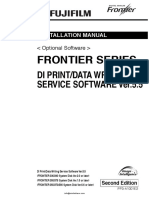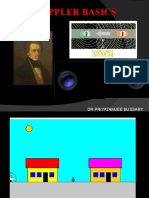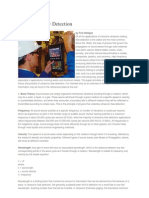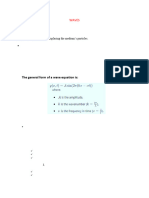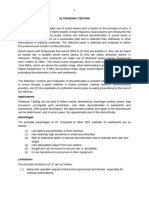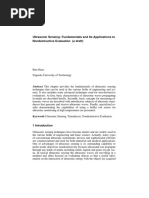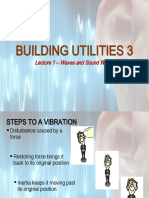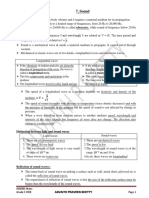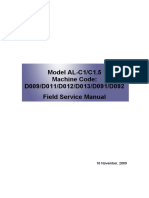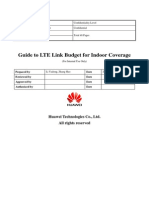Ultrasonic Testing of Welds
Ultrasonic Testing of Welds
Uploaded by
Arun BalaCopyright:
Available Formats
Ultrasonic Testing of Welds
Ultrasonic Testing of Welds
Uploaded by
Arun BalaOriginal Description:
Original Title
Copyright
Available Formats
Share this document
Did you find this document useful?
Is this content inappropriate?
Copyright:
Available Formats
Ultrasonic Testing of Welds
Ultrasonic Testing of Welds
Uploaded by
Arun BalaCopyright:
Available Formats
ULTRASONIC TESTING OF WELDS
1.0 INTRODUCTION Sound transmission is not limited to solid materials.
Other media such as air, water, oil, and grease also
Ultrasonic testing is one of the major NDT methods transmit ultrasonic sound. The velocity with sound
being used to detect internal discontinuities. travels in different media is different. It is to be
Ultrasonic waves are sound waves of high noted that the velocity of sound is constant for a
frequency and inaudible to human ears. Human ears given medium but different for each medium.
can detect sound waves of frequency 20 to 20000
cycles / sec. When the frequency exceeds the wave The velocity of sound in steel is approximately
is ultrasonic wave. Usually ultrasonic waves of 6000 m/s, the velocity of sound in water is
frequency ranging from 0.5 MHz to 10 MHz are approximately 1500 m/s, and the velocity of sound
used for testing of engineering materials. in air is approximately 330 m/s. Sound is
transmitted in the form of wave. The distance
Production of such high frequency ultrasonic waves between two identical points in a wave is known as
were made possible by the discovery of Piezo - wavelength ().
electric effect by Curie brothers. Basically in
ultrasonic testing we inject ultrasonic waves into a The wavelength , velocity V and frequency n are
specimen. related by the formula:
Ultrasonic wave experiences change in its V = n
propagation due to material properties and presence
of discontinuities. The resulting changes are Since the wavelength depends upon the velocity it
detected by testing system and displayed as an also varies from medium to medium, for a specific
indication. Indications are analysed for acceptance frequency. Since the velocity of sound is a constant
as per standards. for a given material, when the frequency is
increased, the wavelength decreases and vice versa.
2.0 BASIC CONCEPTS OF SOUND Hence by selecting different frequencies one has
the control over the wavelength of the sound
Sound waves, audible and ultrasonic, are produced transmitted in the medium.
by vibrating bodies. Vibration is a back and forth
movement and vibration is energy in motion. Detectability of discontinuities by the ultrasonic
Vibrations pass through a medium as a succession sound depends upon the wavelength. The smallest
of particle displacements. The transmission of discontinuity which can be detected under
ultrasonic vibrations through a material is related to favourable conditions is approximately equal to /2
the elastic property of the material. The back and and hence sensitivity of ultrasonic testing can be
forth movement is called “cycle” and cycles in a altered by selection of suitable frequency to have
given period of time is called the frequency (n) and suitable wavelength.
its unit is Hertz (Hz)
Frequencies of the order of 1 MHz to 25 MHz are
commonly used in ultrasonic testing. Production of
2.1 Ultrasonics
such a high frequency vibrations were made
possible by the discovery of piezoelectric effect by
Ultrasonics refers to the sound vibrations beyond
Curie and those high frequency sound waves are
20,000 Hz. When sound is injected into a specimen,
introduced in the material being inspected for
the specimen may absorb the sound energy or
detection of internal flaws.
reflect the sound energy. In either case the
specimen provides a means of learning something 3.0 ULTRASONIC WAVE & THEIR
about the specimen. CHARACTERISTICS
When sound energy is injected into a specimen, the 3.1 Longitudinal Wave
energy is originating from a transducer, which
causes material displacement within the specimen. There are many wave modes of ultrasonic
These displacements move through the specimen vibration. The wave modes most widely used in
and are sensed by another transducer positioned at ultrasonic testing are: longitudinal, shear, surface
the end of the specimen. The energy transmitted by and plate waves. Longitudinal waves are the waves
the transducer may be pulsed or continuous. in which the particle vibrations are moving back
and forth in the direction of wave propagation.
Longitudinal wave can travel through solid, liquid,
Welding Research Institute, BHEL, Tiruchirappalli, India Page UT1 of 10
and gas. Longitudinal wave is also known as
compressional or L - wave. Materi Density Velocity Impedance
al Kg / m m / sec Kg / m2 . sec
3.2 Shear Wave 3
Air 0.001 330 0.3
A wave having particle vibrations perpendicular to Water 1 1500 1500.0
the direction of wave propagation is called a shear Al. 2.71 6350 17208.5
wave. A shear wave may also be known as S - Steel 7.8 6000 46800.0
wave or transverse wave. The velocity of shear
wave is approximately one half of the longitudinal Water has one impedance value and steel another.
wave in the same material. Because of lower So if water is placed in contact with steel and sound
velocity, the wavelength of shear wave is shorter beam is transmitted through the media, there is
than that of longitudinal wave and hence the impedance mismatch. Whenever, there is an
sensitivity is higher for a given testing condition. impedance mismatch, partial reflection and partial
Another characteristic is that shear wave will not transmission takes place at the boundary.
travel through liquid and gas, since there is no
rigidity modulus for liquid and gas. The sound wave used in flaw detection will be
reflected back whenever there is mismatch of
In many respects ultrasonic wave resemble light acoustic impedance. The surface at which the
wave obeying a general wave equation. It travels reflection occurs is called an interface. An interface
with a characteristic velocity in a given material. It is a boundary between two media or materials in
is reflected at surfaces, refracted when crossing a contact with each other and has different acoustic
boundary between different materials and diffracted impedance.
at edges. Ultrasonic wave is also attenuated
depending upon the acoustic impedance Z of the The amount of energy reflected at the interface can
material through which it travels. Figure 1 be calculated from the acoustic impedance (Z) of
illustrates the different modes of sound waves. two materials.
The percentage of reflected intensity of the sound
Longitudinal mode Transverse mode Surface mode
Figure 1 Types of Waves
beam is given by R, where R is
3.3 Acoustic Impedance (Z)
R = [(Z1 - Z2) 2 / (Z1 + Z2) 2] X 100 %
Acoustic impedance (Z) is the resistance of a
material or medium for the sound propagation. It is The percentage of transmitted intensity of the sound
defined as the product of density () and sound beam is given by T, where T is
velocity (v) within that material by
T = [4Z1 x Z2 / (Z1 + Z2) 2] X 100 %
Acoustic Impedance = Density x Velocity
Z = v If we calculate reflection percentage for the
interface between air and steel, 99.9 % of sound
Air has very low impedance, with water being energy gets reflected back and it is true if sound
relatively higher. Aluminium and steel have still travels from air to steel or steel to air. It is true for
higher impedance (Refer Table 1). sound wave generated by the transducer kept on
steel for testing. Hence, to send maximum sound
Table 1 Impedance Values for Different energy into the material under test, air film between
Materials the transducer and the material should be removed
Welding Research Institute, BHEL, Tiruchirappalli, India Page UT2 of 10
by a thin film of oil, grease, glycerin or water as a NZ = D 2 / 4
couplant.
In the far zone the intensity decreases steadily as
Acoustic impedance of the couplant should match the distance from the transducer increases. This is
the transducer and the material under test. If the caused by the fact that the specimen is absorbing
acoustic impedances of the crystal, couplant and energy.
material are Z1, Z2, Z3 respectively, then Z2 must
follow the below relation 3.6 Attenuation
Z2 = (Z1 x Z3) In the far zone, the intensity of sound beam
decreases steadily.
The most common couplants used are water,
glycerin, oil and grease. Sometimes foil, rubber and The term attenuation is used to describe this
wax or cement are also used. condition of energy loss. Attenuation depends upon
the properties of the specimen or medium and
3.4 Beam Intensity characteristics of the sound beam.
Ultrasonic wave is generated by a piezo - electric 3.7 Mode Conversion
crystal. The wave generated is a conical beam
having a beam spread. The intensity of the beam When sound beam strikes an interface between two
throughout the specimen will not be the same materials having different acoustic impedance, at an
because of beam spread, i.e. the intensity of the angle, mode conversion takes place. When
beam decreases as the distance from the centre of longitudinal wave is striking an interface at an
the beam increases. The beam spread can be angle, refraction takes place and since the velocity
controlled by selecting suitable frequency and size of sound is different for different mode of vibration,
of the transducer, D. refracted sound beam is split into two sound waves,
one travels as longitudinal wave and the other
Half Beam Spread is given by the formula travels at lower velocity as transverse wave.
Sin ( / 2) = 1.22 x / D The angular relationship of waves within a medium
can be determined for both longitudinal and shear
Where, / 2 is the half beam spread angle waves by Snell’s law. Snell’s law is defined by the
formula
High frequency transducer will have narrow sound
beam. Similarly, bigger size probe will have less Sin 1 / sin 2 = V1 / V2, where,
beam spread compared to the smaller size probe.
1 - Angle of incidence, V1 - Velocity of sound
3.5 Dead Zone, Near zone & Far in first medium
zone
2 - Angle of refraction, V2 - Velocity of sound
When the crystal generates a beam of sound energy, in second medium
the beam can be classified into three zones, called
“Dead zone“, “Near Zone” and “Far Zone”, So, if the angle of incidence and the velocity of
sound in the two media are known, then it is
In front of the crystal there exists a zone called “ possible to calculate the angle of refraction using
Dead Zone due to the “ringing“ of the crystal. the above relationship. The law can also be used to
During the ringing time, the crystal will not receive determine the angle of incidence, for a specific
any signal. This time is controlled by the damping angle of refraction in a particular medium.
of the crystal. Time duration during which crystal is
not receiving the signal, converted in to distance is
the measure of dead zone.
In the near zone a different condition exists. Here
the intensity varies irregularly. Localised areas of
high and low intensity (maxima and minima) exist
within the area. Near zone prevents the detection of
discontinuities close to the surface of the specimen
and the near zone is given by the formula
Welding Research Institute, BHEL, Tiruchirappalli, India Page UT3 of 10
When ultrasonic vibrations are transmitted into a
relatively thin sheet of thickness comparable to
wavelength, the energy travels in the form of
“plate” or “Lamb” waves. Two basic types of plate
(Lamb) wave exist, one being symmetrical and
other asymmetrical. Plate wave velocity depends
not only on the material through which the wave is
traveling but also on frequency, incidence angle,
and plate thickness.
3.11 Resonance
Figure 2 Mode Conversions
Resonance is defined as the characteristic of a
vibrating body, under certain conditions, to
3.8 Critical Angles resonate or vibrate in sympathy with a vibration
source. The vibration source in this case is the
As the angle of incidence increases the angle of transducer. And the vibrations are continuous
refraction also increases. When the angle of longitudinal waves.
refraction of a longitudinal wave reaches 90º, the
wave emerges from the second medium and travels A resonant condition will exist anytime a
parallel to the interface or surface. The angle of continuous longitudinal wave is introduced into a
incidence, at which the refracted longitudinal wave specimen and reflected “in phase” with the
travels along the interface, is called ‘1 st critical incoming wave. Standing waves are set up with
angle’. considerable increase in amplitude.
For greater angle of incidence, the longitudinal The transmitted and reflected waves in a specimen
wave mode is totally reflected and no longer exists will be “in phase” only when the specimen
in the second medium. Now if the angle of thickness is equal to half wavelength or whole
incidence is increased further, at Second critical number multiples thereof. In other words,
angle, the angle of refraction for the shear wave resonance will occur only when the thickness of the
becomes 90º and the shear wave travels parallel to specimen is equal to half-wavelength or exact
the interface or surface. multiples of half wavelength.
For incident beam angle beyond this second critical From the following relationship
angle, total internal reflection occurs. Both
longitudinal and shear waves are reflected into the V = n where
first medium. No incident beam energy is V = velocity, n = frequency & = wavelength
transmitted through the interface. Usually, the angle it is clear that if the frequency is changed, the
of incidence in the plastic wedge will be decided to wavelength will also change. By applying this one
have shear wave in steel at various known angle of can set up a resonant condition in any material
refraction like, shear wave in steel at 45, 60, 70, 80 thickness, by simply varying the frequency of the
deg. transmitted wave till a half wavelength or one of its
exact multiples equals the material thickness. So
3.9 Surface Wave the resonance will occur anytime a continuous
longitudinal wave is transmitted into a specimen
When the incident beam is at its second critical and the frequency is varied till standing waves are
angle (Shear wave traveling parallel to the surface), set up.
a third wave mode is developed. This wave is
called “surface wave” or “Rayleigh” wave. Its The fundamental frequency is the minimum
characteristic particle vibration is elliptical. Surface frequency at which a given material thickness will
(Rayleigh) wave travels only on the surface of a resonate. It is also the frequency at which resonance
solid material, the penetration is about one amplitude will be the highest. And since the
wavelength. Velocity is 0.9 times that of shear wavelength and frequency are related to material
wave and damped out by placing finger, water or thickness, the fundamental resonant frequency can
grease on the surface. be determined from the formula
3.10 Plate Wave n0 = V / 2T
Where
Welding Research Institute, BHEL, Tiruchirappalli, India Page UT4 of 10
n0 = fundamental frequency Each transducer has a characteristic resonant
frequency at which ultrasonic waves are most
V= Velocity of longitudinal waves within a
effectively generated and received. This resonant
given material
frequency is determined mainly by the piezoelectric
T= Thickness of the material material and its thickness. Transducer responds
efficiently at a band of frequencies centered on the
3.12 Sensitivity & Resolution resonant frequency. The extent of this band known
as bandwidth is determined chiefly by the damping
Sensitivity or the ability to detect a very small characteristics of the backing material that is in
discontinuity is generally increased by using contact with the rear face of the piezo-electric
relatively high frequencies (short wave lengths). element.
Resolution is the ability of the system to give
simultaneous, separate indications from Narrow bandwidth transducers exhibit good
discontinuities that are close together in depth. penetration capability and sensitivity but poor
Resolution is directly proportional to probe resolution. Broad bandwidth transducers exhibit
bandwidth and inversely related to pulse length but greater resolution, but lower sensitivity and
is not affected by frequency. Penetration, or penetration capability, than narrow bandwidth
maximum depth (range) in a material from which transducers.
useful indications can be detected is reduced by the
use of high frequencies. This effect is most 4.2 Probe Types
pronounced in the inspection of material having
coarse grain structure or minute inhomogenities, Search units are of many types and shapes.
because of the scattering of the ultrasonic waves. Variation in search unit construction includes
transducer element material, transducer element
4.0 PROBES thickness, surface area and shape; and type of
backing material and degree of loading.
Generation as well detection of ultrasonic wave for
Figure 3 shows the normal and dual crystal types of
inspection is accomplished by means of a
probes.
transducer element housed in a device called search
unit or probe. The active element in a search unit is
a piezo electric crystal. This crystal works on the
principle of piezo - electric effect. Electrical charge
is developed in the crystal when pressure is applied
to it and when an electrical field is applied; the
crystal mechanically deforms and produces
pressure around it. Piezo-electric crystal exhibits
various deformation process, thickness expansion is
the principal deformation process used in the
construction of transducers for ultrasonic
inspection. The most common types of piezo-
electric materials used for ultrasonic search units
are quartz, lithium sulphate and polarised ceramics
such as barium titanate, lead zirconate titanate and
lead metaniobate.
4.1 Probe Selection
Transducer selection for a given application is done Figure 3 Types of Probes - Normal Probe &
on the basis of size (active area) of the piezo- Dual Crystal Probe
electric element, characteristic frequency,
frequency bandwidth and the type (construction) of 5.0 CALIBRATION AND REFERENCE
search unit. Both the amount of sound energy BLOCKS
transmitted into the material being inspected
(radiated power) and beam divergence are directly Ultrasonic testing is basically a comparison process
related to the size (active area) of the transducer and requires the use of calibration (Figure 4) and
element. Thus it is sometimes advisable to use a reference blocks (Figure 5) for preparing the
larger search unit to obtain depth of penetration or equipment and probe before putting to use on the
greater sound beam area. actual job. Time base calibration is done with
standard calibration blocks, like International
Welding Research Institute, BHEL, Tiruchirappalli, India Page UT5 of 10
Institute of Welding (IIW) calibration block. With
IIW – V1 calibration block, the following
characteristics of the equipment and probe system
can be analysed: Time base Linearity, Resolution,
Sensitivity, Beam spread, Beam angle, Dead zone,
Probe index and Penetration Power.
a) IIW V1 block Figure 6 Pulse echo method, Through
Transmission Method &
Resonance Method
6.1 Pulse Echo Method
In pulse echo method flaws are detected and their
sizes are estimated by comparing the intensity of
b) IIW V2 block
reflected sound from an interface (either within the
Figure 4 Calibration Blocks
test piece or at the back surface) with the intensity
of sound reflected from a reference interface of
known size or from the back surface (back
reflection) serves as a reference point for time of
flight measurements that enable the depth of some
internal flaws to be measured. It is necessary that
an internal flaw reflect at least part of the sound
energy to the receiving transducer for such depth
measurements to be made.
Side drilled hole Block Flat bottom hole block
6.1.1 Principle
Fig 5 Reference blocks
In pulse echo method, short bursts of ultrasonic
6.0 INSPECTION energy (pulse or wave packets) are introduced into
METHODS a test piece at regular intervals of time. If the
pulses encounter a reflecting surface, some or all
Ultrasonic inspection can be performed by of the energy is reflected. The proportion of
energy that is reflected is highly dependent on the
a. Pulse Echo Method size of the reflecting surface in relation to the
b. Through Transmission Method and size of the incident ultrasonic beam. The
direction of the reflected beam depends on the
c. Resonance Method orientation of the reflecting surface with respect to
the incident beam. From the reflected sound beam
Ultrasonic technique in which flaws are detected by both the amount of energy reflected in a specific
measuring intensity and time of flight of reflected direction and the time delay between transmission
sound waves having single frequency is called of the initial pulse and receipt of the echo are
pulse echo method of ultrasonic testing which is measured.
most widely used.
Pulse echo inspection can be accomplished with
longitudinal, shear or surface waves. Straight beam
or angle beam techniques can be used, depending
on test piece shape & inspection objectives. Data
can be analysed in terms of type, size, location
Welding Research Institute, BHEL, Tiruchirappalli, India Page UT6 of 10
and orientation of defects, or any combination of direction. Upon reaching the transducer through
these factors. the couplant the returning pulse causes the
transducer element to vibrate which induces an
6.1.2 Equipment alternating electrical voltage across the transducer.
The induced voltage is instantaneously amplified
The testing system for pulse echo method consists then fed into the display device.
of:
This process of alternately sending and receiving
a. An electronic clock
pulses of ultrasonic energy is repeated for each
b. An electronic signal generator or pulser successive pulse, the display device displaying
the received echo each time.
c. A sending and receiving transducer
d. An echo signal amplifier 6.2 Through Transmission Method
e. A display device.
In through transmission method, flaws are detected
by comparing the intensity of ultrasound
transmitted through the test piece with the
intensity transmitted through a reference standard
made of the same material. Transmission testing
requires two search units, one to transmit the
ultrasonic waves and one to receive them. The main
application of transmission method is the inspection
of plate for cracks or laminations that have
relatively large dimensions compared to the
size of the search units. Immersion techniques
or water column techniques are the most effective
because these techniques provide efficient and
Figure 7 Principle of Operation of UT Pulse relatively uniform coupling between the search
Echo Test Equipment units and the test piece. Good coupling is critical
The operation of a single transducer pulse echo to transmission methods, because variations in
system is as follows: At regular intervals, the sound transmission through the couplants have
electronic clock triggers the signal generator, which corresponding effects on measured intensity, which
imposes a short burst of high frequency alternating affects the evaluation of indications.
voltage on the transducer. Simultaneously the
clock activates a time measuring circuit connected 6.3 Resonance Method
to the display device. The operator pre - selects a
constant interval between pulses by means of a In resonance testing, the transducer is driven by a
pulse repetition rate control on the instrument. sweep oscillator whose frequency is varied
Pulses usually are repeated 60 to 2000 times per continuously. When the natural frequency of the
second. The operator may also pre - select the material thickness or multiple of this frequency,
output frequency of the signal generator. For best is reached, the amplitude of vibration increases
results, some achieve the maximum response of considerably and produces a display on the
the transducer resonance in the vibrating element screen.
and maximum signal to noise ratio (Lowest amount
of electronic noise) in the electronic equipment. This type of equipment is mostly used for
thickness measurement of any material from one
The transducer converts the pulse of mechanical side when properly calibrated. However, the
vibration having essentially the same frequency opposite surface of the test object must be
as the imposed alternating voltage. The reasonably parallel to the surface in contact with
mechanical vibration is introduced into a test piece the transducer.
through a couplant, and travels by wave motion
through the test piece. 7.0 TESTING OF WELDS
When the pulse of ultrasound encounters a
7.1 Surface Preparation
reflecting surface it is reflected and if the reflecting
surface is perpendicular to the direction of travel,
The material surfaces to be used for the scanning
sound beam returns to the transducer. The returning
must allow free movement of the probes and
pulse travels along the same path and at the same
provide satisfactory conditions for the transmission
speed as the initial pulse, but in the opposite
of the ultrasonic waves. The surfaces should be
Welding Research Institute, BHEL, Tiruchirappalli, India Page UT7 of 10
free, (on each side of the weld for a minimum of ½ Depending on the plate thickness, the geometry
skip distance), from weld spatter, loose scale, and the position and nature of the defect,
machining and grinding particles, dirt, paint or scanning may be carried out with shear wave
other foreign matter. probes of a frequency of at least 2 MHz and 70°,
60°, or 45° angle. The weld is scanned on both
It may be necessary to clean and smooth the surface sides from one surface, the scanning zone being a
with a flexible wheel grinder. If smooth, adherent full skip distance. To ensure full coverage of the
scales are present , it may not be required to remove weld and the HAZ the probe should be moved as
them. It may be necessary to remove gross weld near as possible to the centre line of the weld.
surface irregularities, undercut, sharp ridges or
valleys that will interfere with the interpretation The examination should be carried out with
during the test. shear wave probes at a frequency 2 MHz at two
different probe angles (45º and 60° or 70°). To
7.2 Couplant examine welds in the thickness more than 100
mm an additional scanning technique with two
A couplant, usually a liquid or semi - liquid is probes in tandem, positioned at right angle to the
required between the face of the probe and the centre line of the weld is used. Tandem technique
test surface to permit transmission of the acoustic scan is made with 45° probes from the four sides
energy from the transducer to the material under of the weld.
test. Typical couplants include water, oil, grease
and glycerine. The couplant used should be of 7.4 Defect Location
thin film between the probe and the test piece
surface. The accurate determination of the position of a
defect in a welded joint is important not only
7.3 Defect Detection when repairs have to be made but, in an ultrasonic
examination it can give, together with defect
To detect all possible defects, the weld is to be orientation useful information for the
examined over its entire cross section and along the determination of the type of defect. The position of
length specified. For the detection of longitudinal a defect is determined by the distance (Projected
defects the shear wave probe is placed on the path length between probe index and reflector) and
contact surface and kept perpendicular to the weld depth from the surface. The distance and the depth
centre line. In a fixed probe position the ultrasonic can be easily calculated from the path length, probe
beam is directed at only a part of the weld and to angle and thickness.
examine the entire weld, the probe is moved over
the scanning zone in the following ways: 7.5 Defect Size Estimation
i. Lateral motion Techniques for ultrasonic defect size estimation
ii. Traversing motion currently applied are based on the following
principles:
iii. Swiveling motion
Comparison with known reflectors in test
iv. Orbital motion pieces or reference blocks.
Evaluation of defect echo amplitude by
comparison with DGS scales showing the
relative reflectivity of the target expressed as
an equivalent value for a circular reference
reflector at a given distance and given
equipment amplification.
Scanning the edges of a defect with an
imaginary defined line in the beam such as its
axis or its boundary
a b
c 7.6 Distance Amplitude Correction Curve
d
(DAC)
Figure 8 Scanning methods a) Lateral Motion
It is the response curve for a given probe and
b) Transverse method, c) Swiveling
equipment-giving percentage of reflection from a
method, d) Orbital motion
known reflector like side drilled hole, flat bottom
Welding Research Institute, BHEL, Tiruchirappalli, India Page UT8 of 10
hole at various distances from probe. When the
reflector is at near zone, reflection will be
maximum. As distance increases from near zone
the reflection decreases. As distance increases from
the probe surface, within near zone, the reflection
will vary from maximum to minimum. There exists
a small distance in front of probe surface where
reflection will be zero.
The curve giving the details of probe distance along
‘x’ axis and reflection percentage along ‘y’ axis for
a given reflector is called Distance amplitude
correction curve (DAC). To draw DAC, standard
blocks having similar surface finish, nominal
thickness and metallurgy are used. Usually standard
DAC block of thickness T will have reference side
drilled hole or flat bottom hole at T/4,T/2,3/4T
depths from the testing surface. The reflection from
the first hole is brought to nearly 80% of full screen Figure 9 DAC
height by adjusting the gain and the peak point is
marked on the display screen. The adjusted gain is 8.0 TESTING OF PLATE BUTT
called the reference gain. The reflection from the
second and third holes are marked on the screen, WELD
keeping the gain the same. Smooth curve joining all
the three points will be the reference curve (RE) of To test the plate butt weld of thickness (T) a
DAC. reference DAC as per the standard is drawn after
selecting probe angle as per the standard, scanning
Another curve will be drawn taking 50% of each pattern like 0-1, ½- 1 skip, etc. Half skip and full
point and this 2nd curve connecting these three skip distances are marked on the
points is called (RE-6) curve. While testing, any
echo at any distance crossing reference curve is
treated as echo from discontinuity of size greater
than reference reflector. Any echo touching the
reference curve will be treated as echo from
discontinuity of size equivalent to reference
reflector. Any echo between RE-6 and RE will be
treated as echo from discontinuity of size less than
reference reflector.
Depending upon the code, standard, procedure,
equivalent size will be evaluated. Length of the
discontinuity will be measured by using 6 dB drop
method
Welding Research Institute, BHEL, Tiruchirappalli, India Page UT9 of 10
surface from weld centerline and scanning is done. Usually scanning is done at +6 dB higher sensitivity level
than the reference gain RE. When an echo is detected scanning dB is reduced to reference dB and indication
location, indication depth and indication size with respect to reference level are evaluated. Selection of probe
angle, scanning pattern, and number of scanning directions are aimed at complete coverage of weld volume in
the area of interest. Preferably 1:1 drawing may be used as a reference tool to ensure the complete coverage of
weld volume.
9.0 REPORT
The results of an ultrasonic weld examination are given in a report which includes all the necessary
information required, to take decisions on the acceptance of the defects revealed by the ultrasonic
examination, to facilitate repairs of non acceptable defects and to permit the examination to be repeated. The
required information may therefore be divided into following groups:
General data relating specifically to the weld under examination such as order, drawing, and weld
numbers, weld dimensions, time and place of the examination, name and signature of the operator.
Further particulars of the weld with respect to weld preparation, welding procedure, material of the
parent metal, surface condition, temperature etc.
Special data relating to the ultrasonic techniques used including make and type of ultrasonic equipment,
make, type, frequency and angle of refraction of probes, coupling medium, technique of probes,
coupling medium, technique of examination, calibration of the equipment.
Reference gain or Sensitivity setting with reference to the applied specification or reference reflector
used.
Data concerning the results of the examination.
Additional data, which may concern limitations of the examination because of the geometry or other
factors.
Specific requirements agreed upon by the parties involved
Welding Research Institute, BHEL, Tiruchirappalli, India Page UT10 of 10
You might also like
- Minimum Safe Distance Calculator - Pressure TestDocument1 pageMinimum Safe Distance Calculator - Pressure TestArun Bala100% (2)
- Propagation of Sound PDFDocument16 pagesPropagation of Sound PDFHASAN SAIFNo ratings yet
- GCP and 4G Diagnostic ManualDocument305 pagesGCP and 4G Diagnostic ManualRolando Gonzalez ArmasNo ratings yet
- Complex Circuit W Kirchhoff's Law PDFDocument19 pagesComplex Circuit W Kirchhoff's Law PDFMiguel HernandezNo ratings yet
- Manual C4 C5Document78 pagesManual C4 C5Sevenstars Studio100% (1)
- Introduction of Ultrasound Imaging: Sudeepta Maiti 211142001 MSC MitDocument30 pagesIntroduction of Ultrasound Imaging: Sudeepta Maiti 211142001 MSC Mitjacobabraham3471No ratings yet
- ppt1 PDFDocument48 pagesppt1 PDFOmar SalihNo ratings yet
- Met 312 NDT Module 4Document115 pagesMet 312 NDT Module 4ZiadNo ratings yet
- Module 4 Ultrasonic TestingDocument112 pagesModule 4 Ultrasonic TestingSajeesh SajiNo ratings yet
- Ultrasound Techniques-1Document62 pagesUltrasound Techniques-1yahyaNo ratings yet
- Doppler Basics: DR - Priyatamjee BussaryDocument79 pagesDoppler Basics: DR - Priyatamjee BussarydrsanndeepNo ratings yet
- Ultrasonic Testing - Reference MaterialDocument70 pagesUltrasonic Testing - Reference Materialtheophilus.bodduNo ratings yet
- Aliwatya LamashaDocument4 pagesAliwatya LamashaRemison YokoNo ratings yet
- UT Level IIDocument170 pagesUT Level IIhabayeb165No ratings yet
- Ut Ravi Book NewDocument171 pagesUt Ravi Book NewPrakasa Spectro CastNo ratings yet
- 4 Ultrasonic TestingDocument86 pages4 Ultrasonic TestingmohammedNo ratings yet
- Unit-02 NDTDocument20 pagesUnit-02 NDT19114 GovindNo ratings yet
- Ultrasonic Flaw Detection: KnowledgeDocument6 pagesUltrasonic Flaw Detection: KnowledgeShifali GowdaNo ratings yet
- EENG434-10-Ultrasound ImagingDocument57 pagesEENG434-10-Ultrasound ImagingMert BulutNo ratings yet
- Sound PDFDocument53 pagesSound PDFDalitso SimonNo ratings yet
- GED Physics Note3 (Waves)Document4 pagesGED Physics Note3 (Waves)Shahadat Hussain Parvez100% (3)
- Ultrasonic Flaw DetectionDocument15 pagesUltrasonic Flaw DetectionLeonardo.martinezNo ratings yet
- Ultrasound NDTDocument25 pagesUltrasound NDTSai Ram Shyam SundarNo ratings yet
- Module 4 NdtDocument53 pagesModule 4 NdtMuhammed ShafimNo ratings yet
- Wave Motion ScienceDocument14 pagesWave Motion ScienceFredroNo ratings yet
- Sound and Hearing OpticsDocument40 pagesSound and Hearing OpticsJuliana Bianca Dela VirgenNo ratings yet
- WaveDocument14 pagesWaveLitiaMikoNo ratings yet
- Building Utilities 3: Lecture 1 - Waves and Sound WavesDocument120 pagesBuilding Utilities 3: Lecture 1 - Waves and Sound WavesJann BayotNo ratings yet
- WAVESDocument10 pagesWAVESpaulmwadime505No ratings yet
- Ultrasonic TestingDocument22 pagesUltrasonic TestingFatin IshraqueNo ratings yet
- Group-1 - Sound TheoryDocument42 pagesGroup-1 - Sound TheoryAnjelo ReyesNo ratings yet
- BU3 Acoustics PDFDocument257 pagesBU3 Acoustics PDFeyo rimasNo ratings yet
- Therapeutic UltrasoundDocument18 pagesTherapeutic UltrasoundLowell QuadrosNo ratings yet
- Ultrasonic Sensors (Draft)Document20 pagesUltrasonic Sensors (Draft)Moll22No ratings yet
- Sound WaveDocument28 pagesSound Wavehhnflaws2950% (2)
- Fundamentals of Ultrasonic Imaging and Flaw Detection - NI-Tutorial-3368-EnDocument5 pagesFundamentals of Ultrasonic Imaging and Flaw Detection - NI-Tutorial-3368-Enafsajghfd1No ratings yet
- 2021 BUILDING UTILITIES 3 - Module 1 Lecture 1 Waves and Sound Waves (S)Document34 pages2021 BUILDING UTILITIES 3 - Module 1 Lecture 1 Waves and Sound Waves (S)Sophia Manila SillaNo ratings yet
- ULTRASOUND Suad - KHDocument14 pagesULTRASOUND Suad - KHxibsjddhsNo ratings yet
- Basic Ultrasound-Part 1Document32 pagesBasic Ultrasound-Part 1Omary Hassan ChilongaNo ratings yet
- 7 Vy Sou TLQ QZXMe SGZFR 3Document11 pages7 Vy Sou TLQ QZXMe SGZFR 3Aradhana GuptaNo ratings yet
- Basics of Ultrasonic Test Ultrasonic Wave Modes Snell's Law Acoustic ImpedanceDocument7 pagesBasics of Ultrasonic Test Ultrasonic Wave Modes Snell's Law Acoustic ImpedanceHimanshu TiwaryNo ratings yet
- Physics: Lect. No. 6 "Sound Waves"Document14 pagesPhysics: Lect. No. 6 "Sound Waves"Nawras aliNo ratings yet
- SOUND (1)Document6 pagesSOUND (1)jeanjoseo12345No ratings yet
- 7 SoundDocument14 pages7 Soundvincesee85No ratings yet
- WavesDocument74 pagesWaveschonghuagianan0No ratings yet
- Acoustics PDFDocument28 pagesAcoustics PDFCharles Harvey Cabrezos DaabayNo ratings yet
- Physics of UltrasoundDocument4 pagesPhysics of Ultrasound{Phantom}100% (2)
- WavesDocument27 pagesWavesBrianna MalcolmNo ratings yet
- Sound: Perception by The BrainDocument13 pagesSound: Perception by The BrainArjunNo ratings yet
- lecture1Document24 pageslecture1Ahmed GhaliaNo ratings yet
- Sound IXDocument35 pagesSound IXarpankrishna739No ratings yet
- Module 4 PPT NdtDocument77 pagesModule 4 PPT NdtMuhammed ShafimNo ratings yet
- S3 Physics Summary Notes Unit 1 1om6kerDocument17 pagesS3 Physics Summary Notes Unit 1 1om6kerdoornext149No ratings yet
- Unit2 Ultrasonictest NdeDocument35 pagesUnit2 Ultrasonictest NdeKothakota harishNo ratings yet
- An Introduction To Ultrasonic Flaw DetectionDocument7 pagesAn Introduction To Ultrasonic Flaw DetectionDeeNo ratings yet
- Section One:-Sound Waves Section Two:-Sound Intensity and ResonanceDocument12 pagesSection One:-Sound Waves Section Two:-Sound Intensity and Resonanceabdallah.civilengineeringNo ratings yet
- Waves and Optics - HandoutDocument5 pagesWaves and Optics - Handoutnordiea millerNo ratings yet
- Blue and Yellow Illustrative Digital Education PresentationDocument17 pagesBlue and Yellow Illustrative Digital Education PresentationHuỳnh Ngọc TrâmNo ratings yet
- Vibrations and WavesDocument42 pagesVibrations and WavesAdal GanisNo ratings yet
- How Do Waves Behave? How Are They Measured? Physics Lessons for Kids | Children's Physics BooksFrom EverandHow Do Waves Behave? How Are They Measured? Physics Lessons for Kids | Children's Physics BooksNo ratings yet
- MSME OffersDocument43 pagesMSME OffersArun BalaNo ratings yet
- T4 RootDocument1 pageT4 RootArun BalaNo ratings yet
- H8 CapDocument1 pageH8 CapArun BalaNo ratings yet
- (Heating Ventilation and Air Conditioning) : Chennai ChennaiDocument1 page(Heating Ventilation and Air Conditioning) : Chennai ChennaiArun BalaNo ratings yet
- Piping Inspection Summary 30-07-18-1Document8 pagesPiping Inspection Summary 30-07-18-1Arun BalaNo ratings yet
- Delta ASDA B2 User Manual PDFDocument337 pagesDelta ASDA B2 User Manual PDFSỹ HưởngNo ratings yet
- Photovoltaic Solar SystemsDocument21 pagesPhotovoltaic Solar SystemsElias KhouryNo ratings yet
- Libble EuDocument1 pageLibble EuBambang IrawanNo ratings yet
- Ricoh MP 4000 5000 Service ManualDocument606 pagesRicoh MP 4000 5000 Service Manualwilliam lozadaNo ratings yet
- Statement of PurposeDocument3 pagesStatement of PurposeArka Dey RoyNo ratings yet
- UA5000 Hardware Description Manual PDFDocument377 pagesUA5000 Hardware Description Manual PDFYunes Hasan Ahmed Ali100% (2)
- (PDF) Collective ECE ReviewersDocument7 pages(PDF) Collective ECE ReviewersJhoanie Marie CauanNo ratings yet
- IBS Intergration Service V100R002 Technical Guide LTE Link Budget 01-ZHDocument48 pagesIBS Intergration Service V100R002 Technical Guide LTE Link Budget 01-ZHOgg SilverlemoneNo ratings yet
- Class 12 Physics SP 20Document8 pagesClass 12 Physics SP 20Rakesh Kumar Agarwal lNo ratings yet
- OLEDs Advanced Materials - 2021 - Hong - A Brief History of OLEDs Emitter Development and Industry MilestonesDocument24 pagesOLEDs Advanced Materials - 2021 - Hong - A Brief History of OLEDs Emitter Development and Industry MilestonesW.SatoNo ratings yet
- Alarm & Even Programming PDFDocument15 pagesAlarm & Even Programming PDFfreewareNo ratings yet
- V&T 2900CUV Service Manual (New Board) 2010513Document9 pagesV&T 2900CUV Service Manual (New Board) 2010513nelubaiNo ratings yet
- Federal Communications Commission 15.245Document4 pagesFederal Communications Commission 15.245longfei yuanNo ratings yet
- Kathrein SolutionDocument76 pagesKathrein Solutionselahattin AYNo ratings yet
- EC8073-Medical Electronics PDFDocument12 pagesEC8073-Medical Electronics PDFSwetha Ramesh50% (2)
- Kelly Ke Bus Er ManualDocument16 pagesKelly Ke Bus Er ManualVirgis KniukstaNo ratings yet
- ABB HT FAT ProceedureDocument19 pagesABB HT FAT ProceedureHow Peter How100% (4)
- S25FL116K, S25FL132K, S25FL164KDocument90 pagesS25FL116K, S25FL132K, S25FL164Knazim.agabekov9707No ratings yet
- Is Now Part ofDocument18 pagesIs Now Part ofSOLUCIÓN ELECTRÓNICANo ratings yet
- Toshiba Satellite E55 ZRMAA Compal LA-A481P Rev1.0 SchematicDocument55 pagesToshiba Satellite E55 ZRMAA Compal LA-A481P Rev1.0 SchematicdataNo ratings yet
- N-Channel JFET Active CircuitsDocument6 pagesN-Channel JFET Active CircuitsAlya LorijaynNo ratings yet
- Manual de La MartinDocument12 pagesManual de La MartinRené ZavalaNo ratings yet
- How To Solder Beginners GuideDocument17 pagesHow To Solder Beginners GuideGustavo Guto67% (3)
- Vehicle Maintenance and Reconditioning Lab PDFDocument40 pagesVehicle Maintenance and Reconditioning Lab PDFvaratharaju100% (1)
- Information For Operators U.S. Department Info 07001 of Transportation Date: 1/5/07 Flight Standards Service DCDocument1 pageInformation For Operators U.S. Department Info 07001 of Transportation Date: 1/5/07 Flight Standards Service DCKaung MyatToeNo ratings yet
- EEE3100 Lab 3 PDFDocument4 pagesEEE3100 Lab 3 PDFPutri SaidatinaNo ratings yet
- Ebook - Electronics Tutorial PDFDocument213 pagesEbook - Electronics Tutorial PDFHari Laxman M100% (1)




